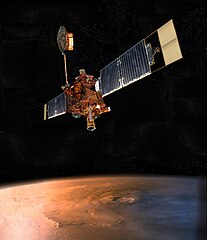Mars Global Surveyor
| ||
 Wizja artystyczna sondy pracującej na orbicie Marsa | ||
| Inne nazwy | MGS | |
| Zaangażowani | NASA | |
| Indeks COSPAR | 1996-062A | |
| Rakieta nośna | Delta II 7925 | |
| Miejsce startu | Cape Canaveral Air Force Station, Stany Zjednoczone | |
| Cel misji | Mars | |
| Orbita (docelowa, początkowa) | ||
| Okrążane ciało niebieskie | Mars | |
| Perycentrum | 261 km[1] | |
| Apocentrum | 54 024,5 km[1] | |
| Okres obiegu | 44,99 h[1] | |
| Nachylenie | 93,26[1]° | |
| Mimośród | 0,88047[1] | |
| Czas trwania | ||
| Początek misji | 7 listopada 1996 (17:00:50[1] UTC) | |
| Koniec misji | 2 listopada 2006 | |
| Wymiary | ||
| Wymiary | kadłub: 1,17 × 1,17 × 1,7 m[1] | |
| Masa całkowita | 1030,5[1] kg | |
Mars Global Surveyor (MGS) − bezzałogowa sonda kosmiczna wysłana na Marsa. Zaprojektowana i wykonana przez NASA i Jet Propulsion Laboratory. Wystrzelona w 1996, stała się początkiem ponownych badań tej planety po ponad 20-letniej przerwie. Z powodu problemów z jednym z paneli słonecznych badania Marsa rozpoczęto dopiero w 1999. Główna misja została zakończona w styczniu 2001, czyli po jednym roku marsjańskim. Najważniejszym instrumentem sondy jest Mars Orbiter Camera (MOC), umożliwiająca robienie zdjęć z rozdzielczością od 1,5 do 12 m/piksel. W czasie swojej misji kamera wykonała ponad 240 tysięcy zdjęć. Na początku listopada 2006 po blisko 10 latach owocnej pracy kontakt z sondą ustał. Dochodzenie wskazało, że najbardziej prawdopodobną przyczyną awarii sondy był błąd w oprogramowaniu.
Zaprojektowanie i zbudowanie sondy kosztowało około 154 mln USD, jej wystrzelenie 65 mln USD, zaś koszty operacyjne oraz analizy danych wynosiły 20 mln USD rocznie[1].
Przebieg lotu
- start z Ziemi − 7 listopada 1996
- wejście na orbitę Marsa − 11 września 1997
- rozpoczęcie badań naukowych − marzec 1999
- utrata łączności z Ziemią − 2 listopada 2006[1]
Osiągnięcia naukowe
- obserwacja zmian pogodowych przez okres ponad trzech lat marsjańskich
- stworzenie map topograficznych
- przesłanie danych, na podstawie których udowodniono istnienie wody na Marsie
Wyposażenie
- Mars Orbiter Camera (MOC) − kamera fotografująca powierzchnię Marsa
- Mars Orbiter Laser Altimeter (MOLA) − wysokościomierz do sporządzenia mapy topograficznej
- Thermal Emission Spectrometer (TES) − instrument mierzący emisję cieplną
- Electron Reflectometer (MAGNETOMETR) − do badań własności magnetycznych
- Gravity Field Experiment (RADIO SCIENCE) − do badań pola grawitacyjnego
Przypisy
Linki zewnętrzne
- strona ze zdjęciami Marsa wykonanymi przez sondę Mars Global Surveyor (ang.)
- oficjalna strona sondy (ang.)
| |||||||||||||||||||||||||||||||
Media użyte na tej stronie
Jet Propulsion Laboratory (JPL) workers in the Payload Hazardous Servicing Facility (PHSF) prepare the Mars Global Surveyor spacecraft for transfer to the launch pad by placing it in a protective canister. The Surveyor spacecraft (upper) is already mated to its solid propellant upper stage booster (lower), which is actually the third stage of the Delta II expendable launch vehicle that will propel the spacecraft on its interplanetary journey to the Red Planet. Once at Launch Pad 17A on Cape Canaveral Air Station, the spacecraft and booster assembly will be stacked atop the Delta vehicle. The Surveyor is slated for liftoff on Nov. 6, 1996 at the beginning of a 20 day launch period.
Original Caption Released with NASA Image:
Artist concept of the Mars Global Surveyor.



